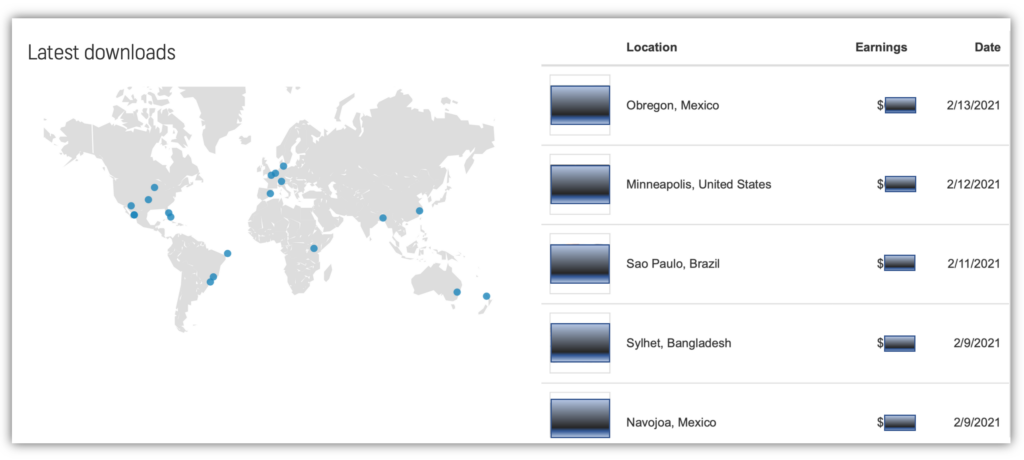In January, 2020, I decided I’d try to earn money with stock photos. In this post, I share how my first year went, and things I learned.
I started by uploading a handful of images to several stock photo agencies, including Pond5 and Shutterstock. To my surprise, within 24hrs, I made my first sale! I don’t know if that’s typical—but I thought it was pretty cool!
Who Buys Stock Images?
You won’t know exactly who buys your images, but you’ll see the city and country where they bought them from. It’s fun to see all the places around the world where your photos end up!

If you’re curious about where your photos end up, just do some Google image searches. You’ll find your photos on websites and blogs all over the world. One of my more popular photos was Photoshoped and used a bunch of different ways.
Which Stock Agencies To Use?
Pond5

In all my time on Pond5, I’ve sold exactly ZERO images. I heard rumors that Pond5 only wants to sell video. Sounds like the rumors are true. I uploaded a handful of video clips to test the theory, and sold 2 of them, which is pretty good considering I only have a grand total of 14 clips in my video portfolio.
Shutterstock
On Shutterstock, I uploaded 30 images in my first 6 months. 10 of them sold. Not too shabby. Now, a little over a year later, I’ve got 65 images in my portfolio. 14 of them were downloaded–some multiple times, for a total of 66 downloads. Yay!
Adobe Stock
In May, 2020 I started contributing to Adobe Stock. In my first two weeks, I sold 3 images! I only had 19 images in my portfolio back then—so it was exciting. By the end of 2020, I had 84 images in my portfolio and 19 downloads.
Payouts (and lack thereof)
Now that you’re all excited and about to launch your career in stock photography, I’m going to bust your bubble. On average, each download earns me anywhere from $0.10 (ten cents) to $1.00. On rare occasions, I make $2.00 per image, and once I got $8 for a photo. The vast majority of the time, I earn a measly 10 cents per download.

When you add up all the time, money, effort, travel, photography, gear, edits, keywords and uploads, you’ll discover you could earn more money by hunting for spare change in your couch cushions.
Scale and Math
Let’s say, hypothetically, that you want to earn money with stock photos. Let’s say there’s 65 images in your portfolio. And let’s say, hypothetically, that 14 images downloaded multiple times in a year (for a total 66 hypothetical downloads). Again, this is all hypothetical. And let’s say the payouts for those 66 hypothetical downloads came to $12.39, hypothetically speaking.
If you increase the portfolio from 65 images to 650 images, and tack a “0” to the other numbers–hypothetically speaking–you’d have 140 images downloaded multiple times–660 downloads to be precise–totaling $123.90 for the year.
If by some miracle, you have 6,500 images in your hypothetical portfolio, and 1,400 images, downloaded multiple times, (for a hypothetical total of 6,600 downloads), you’d hypothetically make $1,239.00 that year.
Yeah… You can see that it’s possible to earn money with stock photos, but not much. It’s just something fun to do in your spare time. Don’t be fooled into thinking you can quit your day job or anything.
What Images Sell?
This is probably the most asked question. I’ve asked it. I still ask it. It’s a question you won’t find a clear answer to. When you search this question online, you rarely ever get back a definitive list of things to take pictures of. You usually find an outdated topic listing that buyers were interested in 3 years ago.
One of my best sellers is a night shot of my solar-powered driveway lights. Other popular images include glasses of wine, and old castle ruins. None of it makes enough sense to for me to say, “Ah ha! That’s what I need to upload!” It all seems kind of random, actually.
It basically comes down to whether or not a buyer needs your photo. You can’t predict, or control that. What you can do is build a portfolio with a wide selection of images to increase your chances of catching someone’s attention. You never know what someone might want next week, next month, or next year.
Checklist for Stock Photos That Might Sell
Study marketing imagery and graphic design. Try and think like an advertiser. Look at magazine images. If you’re taking pictures specifically for a stock agency, shoot from different angles and compositions to give buyers room for copy (text), to crop, or to create multiple ad designs.
Ask yourself, “Is this image something that could be used in an ad?” Don’t take pretty pictures of flowers in your back yard, or ducks in a pond, and say, “I’m going to make millions on stock photography with these pictures!” Images that sell are generally images that are difficult to obtain as well as images from “underserved” niches. Do a search in your favorite stock photo site, as if you were a buyer, and look to see how many thousands of images come up. Niches with small amounts of photos might do better, because there’s less competition. However, maybe there’s not many photos because no one wants or needs those images… So choose wisely.
- Can the image be used in marketing?
- Think like an advertiser
- Will this image help to sell something?
- Is the image difficult to obtain?
- Photos from behind service counters in stores, shops, pharmacies, restaurants, coffee shops, etc.
- Photos from inside areas the general public never ventures into like hydro-electric power facilities, factories, laboratories, repair facilities, manufacturing plants, etc.
- Aerial photos, taken with high-resolution cameras, either by helicopter or drone
- Are there already millions of photos of this topic in the stock agency?
- Unless there’s something really compelling about your cat, a stock photo agency probably won’t want your cat picture
Why Do Photos Get Rejected?
Be sure to read the stock photo guidelines from the agency you want to work with. They all have detailed instructions about basic photography and editing techniques they want to see. Some agencies have YouTube videos that explain what they look for when they screen your uploads. Pay attention to this stuff, and you’ll have more success.
Try not to submit photos with brand names, copyrighted material, or other restricted content. If you take photos of people, be sure to have them sign a model release so you can sell the photo commercially.
When you take pictures, be sure to follow all the general rules of basic, good photography. Keep your horizons straight, follow the ‘rule of thirds’, make sure your subject is well lit, compose your shots thoughtfully, make sure there’s no visual distractions, keep your ISO low, clean your lenses, etc.
When you edit your photos, try and reduce digital noise, clean up chromatic aberrations, and fix barrel distortion. Don’t go heavy-handed with color grading though. Remember, someone is going to buy this photo, and they’ll want to color grade it to match their advertising materials. If you go all Instagram on it, and turn it all teal and orange, some buyers won’t even look at it.
Do I Need an Expensive Camera?
Nope. All the photos in my portfolios in 2020 were shot with a Canon 80D. It’s a capable camera, but by no means “professional”. It does reasonably well in most conditions, but struggles in low light.
The fact that my photos get accepted and sell with this camera is proof that you don’t need a $4,000 camera system like the Canon EOS R5 to create images that buyers want.
You may be interested to learn that the Canon Rebel T7i has the exact same 24 megapixel sensor as the 80D. That means you can get similar results on the T7i for even less money.
If you’re serious about photography and know it’s something you’re going to pursue, I recommend you pick up a quality refurbished Canon 6D Mark II or EOS RP if you can find one. MPB sells them from time to time, and they offer great prices. I’m not affiliated with MPB–but I’ve done business with them, and I know they’re trustworthy, and a breeze to work with.
Conclusion
Now, it’s your turn! Let me know in the comments section if you earn money with stock photos. Is it working for you? How many images are in your portfolios? I’d love to hear from you!



0 Comments